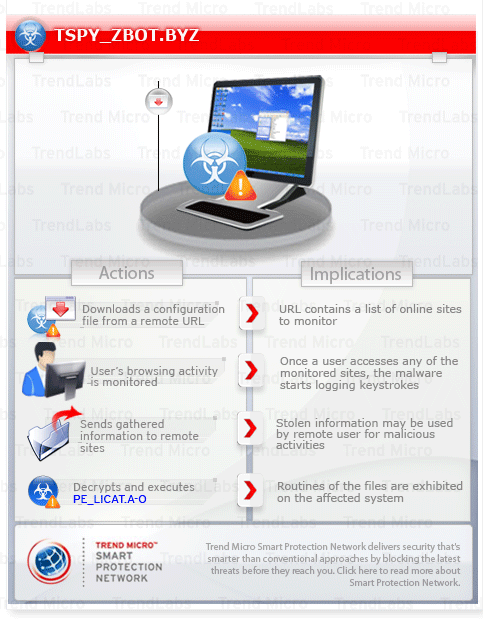TSPY_ZBOT.BYZ
Windows 2000, XP, Server 2003


Threat Type: Spyware
Destructiveness: No
Encrypted: Yes
In the wild: Yes
OVERVIEW
Trend Micro has flagged this malware as noteworthy due to the increased potential for damage, propagation, or both, that it possesses. Specifically, this Zeus malware drops an infector file in the affected system (not an ordinary Zeus malware behavior).
To get a one-glance comprehensive view of the behavior of this Spyware, refer to the Threat Diagram shown below.

This spyware may be downloaded by other malware/grayware from remote sites. It may be dropped by other malware. It may be unknowingly downloaded by a user while visiting malicious websites.
It creates folders where it drops its files. It may be injected into processes running in memory.
It attempts to steal sensitive online banking information, such as user names and passwords. This routine risks the exposure of the user's account information, which may then lead to the unauthorized use of the stolen data. It attempts to steal information, such as user names and passwords, used when logging into certain banking or finance-related websites.
TECHNICAL DETAILS
Arrival Details
This spyware may be downloaded by the following malware/grayware from remote sites:
It may be dropped by other malware.
It may be unknowingly downloaded by a user while visiting malicious websites.
It may be downloaded from the following remote sites:
- http://{BLOCKED}kmzjwjtyzqj.org/news/?s=3
Installation
This spyware drops the following files:
- %Application Data%\{random1}\{random}.exe - copy of itself
- %Application Data%\{random2}\{random}.{3 random alpha character extension name} - encrypted file
(Note: %Application Data% is the current user's Application Data folder, which is usually C:\Windows\Profiles\{user name}\Application Data on Windows 98 and ME, C:\WINNT\Profiles\{user name}\Application Data on Windows NT, and C:\Documents and Settings\{user name}\Local Settings\Application Data on Windows 2000, XP, and Server 2003.)
It is injected into the following processes running in memory:
- ctfmon.exe
- dwm.exe
- explorer.exe
- rdpclip.exe
- taskeng.exe
- taskhost.exe
- wscntfy.exe
It may be injected into processes running in memory.
Autostart Technique
This spyware adds the following registry entries to enable its automatic execution at every system startup:
HKEY_CURRENT_USER\Software\Microsoft\
Windows\CurrentVersion\Run
{GUID} = {malware path and file name}
Other System Modifications
This spyware adds the following registry entries as part of its installation routine:
HKEY_CURRENT_USER
CleanCookies = 0
HKEY_LOCAL_MACHINE
%Windows%\\\\EXPLORER.EXE = %Windows%\\EXPLORER.EXE:*:Enabled:Windows Explorer
Information Theft
This spyware attempts to steal sensitive online banking information, such as user names and passwords. This routine risks the exposure of the user's account information, which may then lead to the unauthorized use of the stolen data.
It accesses the following site to download its configuration file:
- {BLOCKED}mzjwjtyzqj.org/news/?s=2
It attempts to access a website to download a file which contains information where the Trojan can download an updated copy of itself, and where to send its stolen data. This configuration file also contains the following list of targeted bank-related websites from which it steals information:
- !*.facebook.com/*
- !*.microsoft.com/*
- !*.myspace.com/*
- !*.twitter.com/*
- !*.youtube.com/*
- !https://*.mcafee.com/*
- !https://chatserver.comm100.com/*
- !https://clients4.google.com/*
- !https://fx.sbisec.co.jp/*
- !https://mail.goole.com/*
- !https://match2.me.dium.com/*
- !https://server.iad.liveperson.net/*
- !https://www.direktprint.de/ *
- *.barclays.co.uk*
- *.barclays.co.uk*barcaz.php*
- *.barclays.co.uk*bg.php*
- *.firstdirect.com/1/2/*
- *.hsbc.co.uk/1/2*
- *.mybank.alliance-leicester.co.uk*
- *alliance*leicester.co.uk*bg.php*
- *alliance*leicester.co.uk*leicesteraz.php*
- *firstdirect.com*bg.php*
- *firstdirect.com*firstaz.php*
- *hsbc.co.uk*az.php*
- *hsbc.co.uk*bg.php*
- http://www.barclays.co.uk.servaz.cc/barc/bg.php
- http://www.barclays.co.uk.servaz.cc/js/barcaz.js
- http://www.mybank.alliance-leicester.cc/js/leicesteraz.js
- http://www.mybank.alliance-leicester.cc/leicester/bg.php
- http://www.nsbc.cc/az.js
- http://www.nsbc.cc/hsbc/bg.php
- http://www1.banking.firstdirect.cc/first/bg.php
- http://www1.banking.firstdirect.cc/js/firstaz.js
- https://*.ebanking-services.com/*/signin.aspxauthTknW
The downloaded file contains information where the malware can download an updated copy of itself, and where to send its stolen data.
Note that the contents of the file, hence the list of websites to monitor, may change any time.
It attempts to steal information from the following banks and/or other financial institutions:
- Comm100 Live Chat
- Direkt Print
- Google Mail
- LivePerson
- McAfee
- Me.dium
- Microsoft
- Myspace
- Sbisec
- YouTube
- ANZ
- Barclays
- NSBC
- HSBC
- First Direct
Drop Points
Stolen information is uploaded to the following websites:
- {BLOCKED}mzjwjtyzqj.org/news/?s=
Other Details
This spyware does the following:
- It decrypts and executes another malicious file in memory. As a result the following file(s) is created:
- %User Startup%\{4-Random Characters}.exe - detected as PE_LICAT.A-O
(Note: %User Startup% is the current user's Startup folder, which is usually C:\Windows\Profiles\{user name}\Start Menu\Programs\Startup on Windows 98 and ME, C:\WINNT\Profiles\{user name}\Start Menu\Programs\Startup on Windows NT, and C:\Documents and Settings\{User name}\Start Menu\Programs\Startup.)
Variant Information
This spyware has the following MD5 hashes:
- f75a4692b5185286ac0b2ff02da0c32b
It has the following SHA1 hashes:
- 017394d012a6412b42a3846e1c32f420cc146712
SOLUTION
Step 1
For Windows XP and Windows Server 2003 users, before doing any scans, please make sure you disable System Restore to allow full scanning of your computer.
Step 3
Scan your computer with your Trend Micro product and note files detected as TSPY_ZBOT.BYZ
Step 4
Restart in Safe Mode
Step 5
Delete this registry value
Important: Editing the Windows Registry incorrectly can lead to irreversible system malfunction. Please do this step only if you know how or you can ask assistance from your system administrator. Else, check this Microsoft article first before modifying your computer's registry.
- In HKEY_CURRENT_USER\Software\Microsoft\Internet Explorer\Privacy
- CleanCookies = 0
- CleanCookies = 0
- In HKEY_CURRENT_USER\Software\Microsoft\Windows\CurrentVersion\Run
- {GUID} = {malware path and file name}
- {GUID} = {malware path and file name}
- In HKEY_LOCAL_MACHINE\SYSTEM\CurrentControlSet\Services\SharedAccess\Parameters\FirewallPolicy\StandardProfile\AuthorizedApplications\List
- %Windows%\EXPLORER.EXE = %Windows%\EXPLORER.EXE:*:Enabled:Windows Explorer
- %Windows%\EXPLORER.EXE = %Windows%\EXPLORER.EXE:*:Enabled:Windows Explorer
Step 6
Search and delete these files
Step 7
Scan your computer with your Trend Micro product to delete files detected as TSPY_ZBOT.BYZ. If the detected files have already been cleaned, deleted, or quarantined by your Trend Micro product, no further step is required. You may opt to simply delete the quarantined files. Please check this Knowledge Base page for more information.
Did this description help? Tell us how we did.


